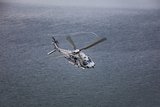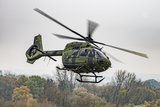AgustaWestland AW159 Lynx Wildcat makes ts first appearance at Farnborough
AgustaWestland, a Finmeccanica company, is pleased to announce that the AW159 Lynx Wildcat will be making its first appearance at the Farnborough International Air Show. The AW159, which will be known as the Lynx Wildcat in Royal Navy and British Army service, is a new generation multi-role helicopter that will replace existing Lynx helicopters. Sixty two aircraft, 34 for the Army and 28 for the Royal Navy, will be built at AgustaWestland's factory in Yeovil with deliveries being completed in 2017.
This month, the airframe for the first production aircraft was delivered on schedule to AgustaWestland by GKN Aerospace, marking the start of AW159 production. The production line located in Yeovil will operate on Pulse Line principles aimed at increasing the efficiency of the aircraft final assembly process through reducing the time and man hours required. Once fully established, the final assembly process, from receipt of the airframe to delivery of the completed aircraft for acceptance testing, will take just 3 months for each aircraft. The production line will deliver at a rate of one AW159 Lynx Wildcat per month for the UK MoD's order, however, the Pulse Line will have the capacity to more than double that rate to meet potential AW159 export orders.
The first aircraft will be delivered at the end of 2011 with the aircraft becoming fully operational with the Army in 2014 and the Royal Navy in 2015. The British Army's AW159 Lynx Wildcat will perform a wide range of tasks on the battlefield including reconnaissance, command and control, transportation of troops and materiel, and the provision of force protection. The Royal Navy variant will provide an agile maritime capability providing anti-surface warfare capability and force protection and will operate in support of amphibious operations and be an important element in defending ships against surface threats. There will be a high degree of commonality between the Army and Royal Navy helicopters that will mean that an aircraft can switch roles easily, principally through the changing of role equipment.
The AW159 is powered by two new generation LHTEC (a partnership between Honeywell and Rolls-Royce) CTS800 engines, each capable of continuously producing 1281 shp giving the aircraft exceptional hot and high performance. The aircraft has an all up mass of 5790 kg with a built in capability to increase that to 6250 kg. The cockpit includes a fully integrated display system utilising four 10x8 inch primary displays. Sensors include a nose mounted IR/TV imager with built in laser designator and for the maritime variant the Selex Galileo 7400E 360 degree active array radar. For self protection the AW159 has a comprehensive integrated defensive aids suite comprising a missile warning system, radar warning receivers and a countermeasures dispensing system.
Additionally the Royal Navy's AW159 Lynx Wildcats will be capable of carrying a range of weapons including torpedoes, depth charges and the Future Anti-Surface Guided Weapon (FASGW). The AW159 performed its maiden flight at AgustaWestland's Yeovil facility on 12th November 2009. Since then it has completed more than 30 hours of test flying and it will joined by two more test aircraft later this year. The AW159 programme for the UK MoD continues to be on time and on budget and was the first major project to be awarded under the Strategic Partnering Arrangement signed by the UK Ministry of Defence and AgustaWestland in June 2006.
Source: AgustaWestland
More from Defence Helicopter
-
![Germany to send WS-61 Westland Sea King helicopters to Ukraine]()
Germany to send WS-61 Westland Sea King helicopters to Ukraine
Germany has committed to sending Ukraine six of its 21 retiring WS-61 Westland Sea King multirole, amphibious helicopters.
-
![Boeing secures $271 million to advance modernisation of US Special Operations' MH-47G Chinook]()
Boeing secures $271 million to advance modernisation of US Special Operations' MH-47G Chinook
Boeing has clinched a major contract modification to further its backing of the US Special Operations Command’s MH-47G Chinook aircraft modernisation effort.
-
![Dubai Airshow 2023: South Korean homegrown helicopters make international debut]()
Dubai Airshow 2023: South Korean homegrown helicopters make international debut
Two KAI helicopters, the KUH-1E utility helicopter and the Light Attack Helicopter (LAH), have taken centre stage at the Dubai Airshow 2023.
-
![Italian Navy receives final NH90 helicopter]()
Italian Navy receives final NH90 helicopter
The Italian Navy now boasts a fleet of 56 NH90 helicopters comprising 46 SH-90As and 10 MH-90As.
-
![Argentina seeks AW109 and CH-46 Sea Knight helicopters]()
Argentina seeks AW109 and CH-46 Sea Knight helicopters
The Argentinian Air Force (FAA) and the Argentinian Naval Aviation Command (COAN) are looking for options to upgrade their helicopter fleets.
-
![DSEI 2023: Lockheed to produce about 40% of Black Hawks on UK soil if it wins NMH contest]()
DSEI 2023: Lockheed to produce about 40% of Black Hawks on UK soil if it wins NMH contest
Lockheed Martin promises a boost to the British job market and export opportunities, while strengthening ties with Poland and positioning the UK for a future in rotorcraft technology in the event of a New Medium Helicopter competition triumph.


























